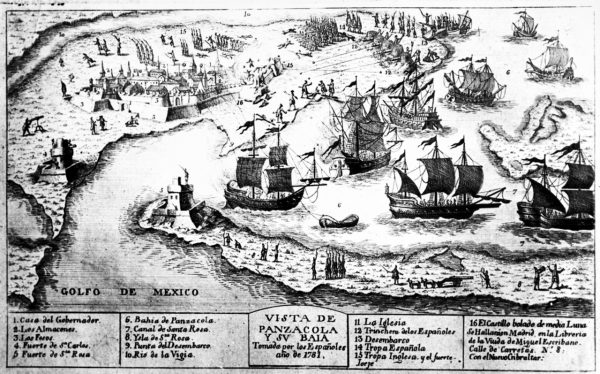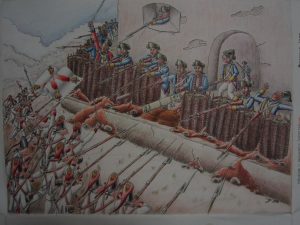Source:GEHM
After nine days at sea, he arrived at the island of Santa Rosa, which closed the bay that gave access to the city. The entrance to the bay was defended by the fort of San Carlos on the continental side and a battery of cannons on the island of Santa Rosa.
Gálvez immediately landed his troops on the island, easily taking his battery and driving off the British brigs, Mentor (16) and Port Royal, which were firing at them from inside the bay. The crossfire at the entrance had been cancelled, so the ship San Ramón (64), the flagship of the fleet and commanded by the chief of the naval force, Calvo de Irázabal, tried to pass it but ran partially aground on a sandbank.
Fortunately, he managed to escape the trap and escape the cannon fire from the fort, but in view of what had happened, Calvo de Irázabal forbade any ship to pass through the mouth. Irázabal and Gálvez exchanged letters with harsh words and accusations, but after several days, Gálvez realised that his soldiers’ conditions were not good and that the weather was worsening, so that in the event of a storm they would put to sea to avoid running aground, which would mean the failure of the expedition.
It happened then that with four vessels that were in his charge because they were from New Orleans, the tenacious Gálvez launched himself against the mouth of the bay. At their head was himself, onboard the Galveztown (6), a captured English brigantine, a gift from the Americans to the Spanish marshal. As he set his bow into the straits of the bay, he insolently hoisted the admiral’s insignia and addressed bold words to the rest of the squadron: “A thirty-two-gauge bullet picked up in the camp, which I am leading and presenting, is one of those that the Fort at the entrance gives out. He who has honour and courage, let him follow me. I go ahead with the Galveztown to take away his fear”. And so, under the fire of the fortification, the brigantine followed by the sloop Valenzuela and two gunboats entered without running aground and without suffering hardly any damage from the enemy.
Ardent or dead ashamed, the rest of the Spanish squadron imitated the action of the four brave men, leaving the San Ramón (64) alone, which set sail for Havana with the furious Calvo Irázabal on board. Clearing the bay of enemy vessels, Bernardo set foot on land and set up camp while agreeing with the English general John Campbell to respect the people and buildings of the town of Pensacola, something that the British then failed to do by setting fire to the town.
Pensacola had three forts in a line that were successively higher than the previous ones, Fort George, El Sombrero and the highest of them, Fort de la Medialuna. Both Campbell and Gálvez knew that if this last fortress fell, the rest would also fall like dominoes reaching Fort George, which was the one that controlled the city under fire. Thus, both sides concentrated their forces at Fort de la Medialuna. On 22 March, after a terrible march of 140 kilometres from Mobile, Ezpeleta and his 500 soldiers, including cavalry and several artillery pieces, arrived. Two days later, reinforcements also arrived from New Orleans, with 1627 men, 3 ships and siege artillery. He now had 33 ships and 4,922 men.
Don Bernardo felt he had sufficient forces and ordered the construction of a series of trenches to gradually approach the fort, while the 2,000 English soldiers and their 500 Indian mercenaries were constantly harassing the besiegers, in fearsome skirmishes in which Gálvez was even wounded. It was clear how much the Indians benefited the British, so Campbell refused to stop using them.
To make matters worse, the weather did not help, waterlogging the trenches and making the living conditions of the Spanish soldiers difficult, and after days of anguish, they saw a squadron approaching. Fortune smiled on them, they were the reinforcements promised by Saavedra, some 20 ships and 3234 men, commanded by the squadron commander Don José Solano Bote and distributed as follows:
- 11 ships of the line: San Luis (80), Solano’s flagship, San Nicolás (80), San Francisco de Asís (74), Arrogante (74), Guerrero (74), San Gabriel (74), Magnánimo (74), Gallardo (74), San Francisco de Paula (74), Dragón (60) and Astuto (58).
- 1 frigate: Nuestra Señora de la O (36) commanded by Gabriel de Aristizábal.
- 4 French ships-of-the-line: Palmier (74), Destín (74), L’Intrepide (74) and Le Triton (64).
- 2 French frigates: L’Andromaque, Licorne.
- 1 French brig: Levrette.
- 1 cutter: Le Serpent.
- 1600 soldiers under the command of Field Marshal Juan Manuel de Cagigal.
- 909 sailors.
- 725 French: Regiments of Orleans, Poitou, Agenois, Gatinois, Cambreis, Du Cap, Army artillery and Navy artillery.
With them, the forces under Gálvez’s command totalled 8156 men from the most diverse origins and he had almost completed the placement of the siege artillery under the protection of the trenches located in front of the Fort de la Medialuna. The blow to the morale of the British must have been very hard, and even the Indians stopped attacking in anticipation of the British defeat.
In 8 May 1781, the Spanish artillery, with the distance estimate of an English deserter, opened fire for the first time, so accurately that a grenade hit the enemy powder magazine, causing a terrible explosion that killed 105 defenders and “transformed the redoubt into a heap of rubble”. After this horrifying event, the Spanish troops entered in four columns into the fortification full of corpses and the dying, which surrendered without resistance.
Share this article
On This Day
- 1503 Battle of Cerignola (Italy).
- 1522 Santiago de Cuba is granted the city status by Carlos I.
- 1589 Margarita de Saboya is born.
- 1611 Archbishop Miguel de Benavides founded the University of St Thomas in Manila.
- 1777 José Primo de Rivera, Hero of the Sieges, was born in Algeciras.
History of Spain
26 August 2020
27 January 2021
Communism: Now and Then
23 December 2022
28 July 2021










